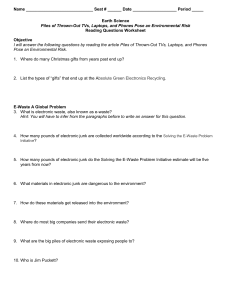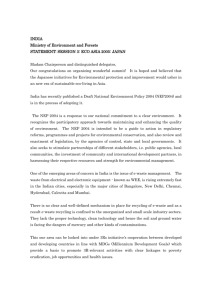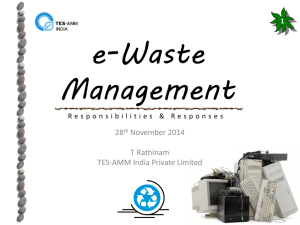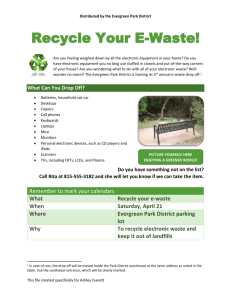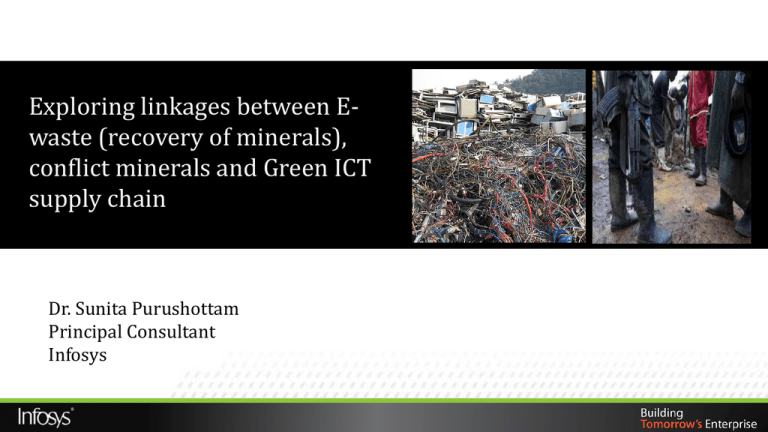
Exploring linkages between Ewaste (recovery of minerals),
conflict minerals and Green ICT
supply chain
Dr. Sunita Purushottam
Principal Consultant
Infosys
Two problems
Conflict minerals & E-waste
2
The problem statement: Conflict Minerals
The Conflict Minerals Trade Act : Regulation issued by the SEC on
last week of August 2012, Disclosing the Use of Conflict Minerals,
was greeted with a decidedly mixed response by sustainable
investors and other stakeholders.
The regulation requires US corporations to disclose whether their
products contain conflict minerals, including tantalum, tin, gold, and
tungsten, which have been smuggled out of the Democratic Republic
of the Congo (DRC). As armed groups use payments for materials to
fund a conflict which has resulted in the loss of more than five
million lives.
3
Where and What?
•
15% and 20% of the world’s supply of tantalum,
•
5% of its tin,
•
about 1% of its gold
•
a small portion of its tungsten.
•
These elements are integral to electronics
manufacturing.
5 million dead
Child labor
Human Rights/ Sexual Abuse
4
The problem statement: E-waste
•
Huge waste volumes
•
Biggest and fastest growing manufacturing
waste.
•
Landfilling of E-waste
•
Informal recycling
•
Trans-boundary E-waste dumping
•
Closing the loop
3.16 million tons
430,000 tons or 13.6 % was recycled,
USA generated
Only
Trashed – in landfills or incinerators or send overseas
5
Challenges in proper E-waste recycling in developing world
• Trans-boundary dumping is common and largely
unregulated. Dealing with imported E-waste and rising
domestic E-waste
• Goods move from developed nations to known and
unknown destinations in developing world
• Improper dismantling leads to soil pollution is among
the other detriments of improper and unorganized ewaste management and handling.
• Operation of unorganized recycling – scrap dealers
• Little or no regulatory checks on scrap dealers
6
Sustainable Supply Chain
E-waste and Conflict minerals
Exploring linkages
7
Business Ethics and Sustainability issues pertaining to mining –
Gone for a toss?
• Unscientific extraction
• Land Management
• Water pollution- toxic
• Water Management
• Land pollution – toxic waste dumping
• Waste Management
• Worker under gunpoint
• Worker Safety
• What Climate Change?
• Climate Change
• Mine establishment and closure
• Mine establishment and Closure
• Non existent Stakeholder Engagement
• Stakeholder Engagement
• Human Rights violation
• Human Rights
• Community suppression
• Community Development
• Gun culture
• Supply Chain Management
• Militant profitability
• Transparency and accountability
• Business Sustainability
8
Sustainability issues mapped across the value chain
Value Chain
Supplier
Tier 2
Own Operations
Scope 1 and Scope 2
Supplier
Tier 1
Supply Chain
Extraction/
Raw Material
Value chain
Issues
Suppliers
Downstream Scope 3
Customers/End of Life
Ethical
Common across the value chain
Upstream Scope 3
Suppliers
Sustainable Supply Chain criteria:
• Supply Chain performance and risk management
• Procurement : Ethical and responsible sourcing
• Product design improvements and environmental
friendly materials
• Material compliance and EOL management
• Logistics Management
Pr
od
uc
er
Transportati
on
Over extraction
Labor Issues
Emissions
Violations
Inefficiencies
Inefficiencies
Biodiversity
Audits
Distr
ibuti
on
Retailer
U
s
e
r
Legal
Labor
Health and Safety
Resources
Waste disposal
Air Emissions
Waste Water
Renewables
End of
Life /
Dispos
als
Product selection
Compliance
Use (TCO)
Inefficiencies Labeling
Product Compliance
Take back systems
Local communities
EHS Compliance Reverse Logistics
Recycle and reuse
Working condition
Litigations
Waste management
Over packaging
Reputation
9
Emissions
Increasing demand for Supply Chain Sustainability Disclosure
Conflict minerals disclosure (SEC ruling)
FMD
Wal-mart Questionnaire
EPEAT
Supplier Scorecards
Disclo
sures
EICC Supply Chain
CDP Supply Chain
GRI Sustainability Reporting
EU Waste Directive, WEEE and REACH
End of Life Reporting, EPR
Vodafone, BT Supplier assessments
Consolidating disparate disclosure
information across all countries for easy
retrieval and analysis to inform supply
chain performance
Increasing adoption of SA8000 standards
and other supply chain standards
Note : Mandatory disclosures highlighted in dark
10
Conflict Minerals and E-waste linkages for a sustainable supply chain
Conflict
minerals
E-Waste
Source : UNEP 2007, E-waste Management Manual Volume II
11
E-waste Value Chain
Generation
Producer of EEE
Purchase of EEE
Households
End of life
Step 1
Stockpiling
and Collection
Aggregators
Step 2
Purchase & Resale
Handling and
Brokering
Segregators
Manual Dismantling
Step 3
Recyclers/ Smelters
Processing
Step 4
Businesses
Refining and Conditioning
Distributors of Recovered Materials
12
R
E
U
S
E
Life Cycle Analysis of Materials
• Six key metals - aluminium, cobalt,
copper, gold, palladium, and tin – are
used in the electronic industry.
• Published data on embodied carbon
and energy is available in the ICE
(Inventory and Carbon and Energy)
database for Aluminium, Copper and
Tin.
• Conclusion: mining of metals is
energy and carbon intensive and
therefore it is more efficient to
recycle metals for use in the
electronics industry.
Embodied
Energy
(MJ/kg)
Embodied
Carbon
(kgCO2/kg)
Virgin
218
11.46
Recycled
28.8
1.69
70
3.83
Recycled
(High grade
scrap)
17.5
0.96
Virgin
250
13.7
Material
ALUMINIUM
COPPER
TIN
Virgin
No published data for Recycled
13
Reduction of
embodied
carbon in
recycled
compared to
Virgin
85%
75%
Guidelines for Producer - End of Life destination
*Adopted from end of life destination used for automotive sector
14
Building the Sustainable Supply Chain
15
A phased approach to Sustainable Supply Chain
• Waste volumes taken back
Reporting
Monitoring /
Tracking
• Percentage of materials sourced
from conflict zones
• Recyclability and reparability
• Support and service, extended
Engagement
warranty, upgradability
Identification
• Supplier Audits
Setting Goals
• Supplier education and awareness
• Working with certified suppliers
16
Sustainable EEE Value Chain
Supply Chain Risk Management
Raw materials
inputs
Packaging
Design
Packaging
Manufacture
Product
Manufacture
Distribution
Retail
Use
End of Life
Analytics and Reporting
Ethical and
responsible
sourcing
•Support sustainable
forestry and mining
•Green procurement
policy
•Identify sustainable
material selection`
Product design
improvements
•Material compliance
(as defined for food
safe packaging)
•Alternative
materials
•Define KPIs for use
of recyclable
content/compostabl
e material for new
products
Product and packaging
manufacturing
•Identify methods for
carbon reduction in
facilities
•Identify waste and water
reduction measures
•Material reduction
•Packaging dimensions
•Define KPIs for waste,
energy, water, carbon in
facilities,
Distribution and transportation
•Identify methods for carbon
reduction
•Identify alternate fuel/ modes for
transportation
•Identify methods to reduce
emissions (both carbon and
criteria pollutants)
•Logistic optimization –
synchronize truck loads.
•Track and monitor carbon during
distribution
Carbon and Energy Management
Supply Chain Performance
Assess suppliers to get into the compliant suppliers pool.
Awareness and training,
Supplier self assessment and full audit
Managing the compliant suppliers' pool.
Influencing
Consumers
•Educating consumers
•Exercising
sustainable choice of
packaging
•End of life disposal
options
•Work with end users
to collect and recycle
packaging material
Steps to conflict –free electronics
Leading electronics companies are making progress in eliminating conflict minerals from their supply chains,
but still cannot label their products as being conflict free.
Tracing
•
Tracing - Finding the source of minerals in products –
mapping smelters in the supply chain
•
Auditing – Smelters audited by third party through conflict
free smelters(CFS) program
•
Certification – Certification by local government body
Auditing
Certification
•
•
Increase traceability and raising awareness for humane mining
Recovering the minerals from IT disposal could lessen the demand from this deadly source.
18
Leading ICT companies – On Conflict Minerals
• Committed to uphold the EICC code of conduct for suppliers. Direct suppliers to
set public goals to reduce GHG impacts. Commitment to the IDH Sustainable
Electronics program FOR Innovative workforce management
• Intel was the first company to publicly commit to making a fully conflict-free
product within a deadline—a conflict-free micro-processing chip by 2013.
• Intel chairs the review committee for the smelter audit program
• Co-chairs the industry association work group on conflict minerals, has visited
50 smelters, Co-founded a program with HP and GE to pay for smelter audits
• Visited eastern Congo to better understand how the company can have a
positive impact.
HP has been active at multiple levels.
• Require its suppliers to use conflict free minerals
• Co-founded the smelters incentive program.
• Is helping Congo develop a clean minerals trade,
• It also signed onto the multi-stakeholder group on strong SEC regulations.
Leading ICT companies – On E-waste and EPR
• Dell offers free recycling in most places where it does direct business
• Dell provides information for recycling for its consumers in other geographies
• Its takeback program is especially effective in USA
• HP offers hardware recycling services for business consumers all over the world (in
46 countries of its operations)
• HP offers Consumer Buyback in USA
Nokia was one of the founders of the Electronics Coalition, which identified four key
areas of concern in relation to the proposed directives:
• Producer responsibility.
• Industry responsibility for historic waste.
• Responsibility for free riders and orphan products. L
• Looking at substance legislation from a sound scientific perspective.
Closing the loop – Life cycle of EEE
At every stage in the life-cycle of specific products there are
social and environmental impacts, or externalities, on the
environment and on people. In addition, governance, or the
accountability of organizations to their stakeholders for their
conduct, is important at every stage and throughout the supply
chain.
Refurbished
product
Retailer
• Producers of EEE
• Regulator
• Consumer and generator
• Recycler
Consumer
Recycler
• Retailer
• Refurbisher
Collection
Centers
21
Present Situation
Future Situation
Industry
• Resource rich consumption
processes
• Less importance to reuse
• EPR laws formulated
• Design for dump
• Conflict minerals awareness
•
•
•
•
Recycler
• Expectation of profits
• Difficulty in recycling
• Absence of reverse logistics
• Rise of recycling increasing
profitability
• Wide scale reverse logistics
• Recycling centers
Consumer
Future of EEE from different stakeholder perspectives
•
•
•
•
•
•
•
•
•
High consumption
Use and throw
Landfill of E-waste
Rising awareness of E-waste
Rising sustainability awareness
22
Emphasis on process efficiency
Designed for recycling and DFE
EPR laws functional
Sourcing conflict free minerals
Conscious consumption
Proper recycling
Aware about conflict minerals
E-waste management and high
awareness of end of life disposal
Steps to bridging the gap Conflict minerals and E-waste * - recovery and
recycling
Industry
• Adopting product specific approach
• Adopt green PLM*
• Green procurement and sourcing from
conflict free zones
• Assessment of end of life disposal in design
phase
• Industry specific approach
• Strengthen reverse logistics
• Embrace EPR and product stewardship
• Strengthening take back programs
• Alignment of Marketing Strategies
• Market recycled products
• Increase vendor and customer awareness
• Promote discounts for customer returns
• Increased marketing of green raw materials
and green production processes
Government
• Appropriate regulations and global
standards for E-waste disposal and
recovery
• Job generation in the recycling sector by
supportive policies
• Streamlining operations of scrap vendors
by awareness and incorporation into
government authorized vendor list
• Sound end of life management
technology adoption – authorized
recycler list
• Regulated refurbishing and reuse
practices
23
Recycler
• Follow sound EOL management
• Adhere to EOL regulations
• Works towards strengthening
reverse logistics
• Creates jobs
• Creates awareness
• Works with industry for take back
programs
Customers
• Greener electronics – conflict free
• Local corporations to institute take
back programs
• Conscious consumption
• E-waste handed to authorised
recyclers
Ecosystem for Sustainable Supply Chain
Need for Global ICT standards which helps to cut e-waste and make the ICT supply chain greener
PRODUCER
• Set waste recovery targets
• Provide permanent collection
infrastructure
• Remanufacture and reuse - Work
with recyclers
• Required by law to disclose source
of minerals in products
• Amend supply chain policy for
conflict-free sourcing
• Getting smelters audited
• Buying from conflict free smelters
• Help Congo develop a clean trade –
ensuring conflict – free is not Congo
free
• Support livelihood projects to help
mining communities
• Moving beyond law for the next
“supply chain issue”
• Adopt proactive and not reactive
stance to sustainable supply chain
• Systems to address and mitigate
supply chain risks
PRODUCER - DESIGN
• Avoid regulated and restricted
materials
• Design for disassembly
• Use recycled materials where
possible
• Reduce number of material
types
• Eliminate incompatible nonseparable materials
WASTE RECYLCER - RECOVERY
• Improved E-waste Collection
• Efficient collection
infrastructure
• Adopting efficient processing
• Advanced sorting technology
• Improved technology for
recovery
COLLABORATION
GOVERNMENT - REGULATIONS
• Designer, producer and waste
management to define
sustainability aspects of product
design
• Engage in multi-stakeholder
forum on conflict minerals and
E-waste to adopt and learn from
similar industries
• Join hands with other industries
and consortiums
• Promote policies which support
recyclers
• Remove subsidies on virgin
material use
• Introduces SOPs for recycled
material use
• Define roles and responsibilities
for stakeholders in E-waste
management and recovery
• Enforcement of regulation
24
THANK YOU
www.infosys.com
The contents of this document are proprietary and confidential to Infosys Limited and may not be disclosed in
whole or in part at any time, to any third party without the prior written consent of Infosys Limited.
© 2011 Infosys Limited. All rights reserved. Copyright in the whole and any part of this document belongs to
Infosys Limited. This work may not be used, sold, transferred, adapted, abridged, copied or reproduced in
whole or in part, in any manner or form, or in any media, without the prior written consent of Infosys Limited.

